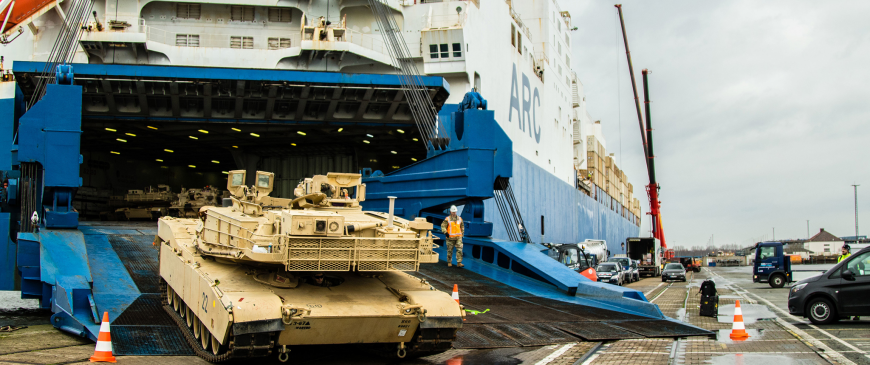
Europe must take on its own defense responsibilities
As they look at the state of their coronavirus-hit economies and U.S. President Donald Trump’s poor standing in opinion polls, many European leaders may be tempted to put on hold any plans to meet NATO’s target of spending 2 percent of gross domestic product on defense. But Europeans need to wake up. Trump is not a reliable ally, and the damage he has done to the trans-Atlantic partnership is likely to linger.
Trump’s hostility to NATO has been obvious since he called into question its Article 5 mutual defense guarantee during his last presidential campaign. We now know, according to former national security adviser John Bolton’s tell-all memoir, that Trump was ready to pull the U.S. out of NATO at its 2018 summit.
In recent weeks Trump announced without warning that the U.S. will withdraw 9,500 — more than one quarter — of the 34,500 troops it has stationed in Germany because the German government is not spending enough on defense. Then at a Washington press conference with Polish President Andrzej Duda, Trump said a large number of NATO countries were “delinquent” and declared that Europe was taking “tremendous advantage of the United States on trade.”
Trump may not understand how NATO works or the value to the U.S. of having troops in Germany, but it is true that the U.S. carries a disproportionately large share of the financial burden of defending Europe. During his presidency, Barack Obama also accused Europe of being “complacent” about its own defense — though he was rather more diplomatic.
Only a handful of European NATO members have met the alliance’s target of spending 2 percent of GDP on defense over the past 20 years, while the U.S. has consistently exceeded it, spending 3.1-4.9 percent. But Europe’s problem is not just the amount it spends on defense, but the inefficiency and ineffectiveness of its spending: Europeans get far too many systems and far too little military capability for their money.
The European Commission’s 2017 fact sheet on European defense reported that European Union member states operated 178 different major weapons systems; the U.S. had only 30. EU member states have 17 different types of main battle tank; the U.S. has one.
This proliferation of weapons systems leads to high unit costs for short production runs, and a lack of interoperability. And European spending is not directed to ensuring that troops can fight when needed. The European members of NATO have almost 1.9 million active-duty troops, while the U.S. has 1.3 million and Russia about 900,000. But very few of the European forces can be deployed in a crisis.
Politically and economically, this is a bad time to try to get European politicians to think seriously about increasing and rationalizing defense spending. The EU’s economic forecast for spring 2020 foresees a contraction in real GDP of 7.4 percent this year, albeit followed by an increase of 6.1 percent in 2021.
Some of Europe’s biggest investors in defense are in NATO but not in the EU. The U.K. accounted for 16 percent of defense spending in Europe in 2019, according to the Stockholm International Peace Research Institute. But despite some early promise, Britain seems to have lost interest in any institutionalized cooperation with the EU on foreign and security policy. Relations between the EU and NATO member Turkey, which accounted for another 7 percent of European defense spending last year, have rarely been worse.
Despite such difficulties, the fact that NATO and the EU are currently both reassessing the security environment presents an opportunity for a more joint approach.
NATO is engaged in the #NATO2030 process, which Secretary General Jens Stoltenberg hopes will strengthen political consultation in the alliance. Meanwhile, by the end of 2020 the EU aims to complete a process to assess the threats it faces, which the bloc calls its “strategic compass.” These two efforts need to complement each other to produce a shared view of the threats to Europe, and the creation of a forum for political dialogue on security where European countries, regardless of whether they belong to both the EU and NATO, can discuss appropriate responses.
Europe’s ability to counter threats will depend on making its money go further by spending it efficiently, both nationally and multilaterally. The commission should do more to ensure that more defense procurement involves competitive tendering, rather than member states awarding contracts to national champions. But it should not try to shut defense firms from non-EU NATO countries out of the European market.
The commission stands more chance of influencing the research and procurement decisions of member states if it has a substantial budget to dangle in front of them. It should keep pushing back against cuts proposed earlier in the year to the defense elements of the EU’s next seven-year budget. And the commission needs to be more open to the participation of “friendly” countries in EU-funded programs.
Joe Biden, a former U.S. vice president and a contender in the current presidential race, would be an easier president for Europeans to work with than Trump has been. But Biden’s victory in November is not guaranteed. Moreover, the forces in U.S. society that propelled Trump to power in 2016 will still exist, and may return in 2024.
Even if they would rather pretend that nothing is changing, the EU and as many non-EU, Europe-based NATO members as are willing to do so need to pay attention to Trump’s message. And they need to start thinking about how to defend Europe and deter potential adversaries with reduced U.S. help.
Ian Bond is the director of foreign policy at the Centre for European Reform think-tank.
